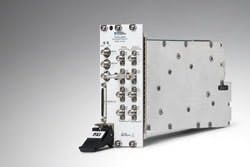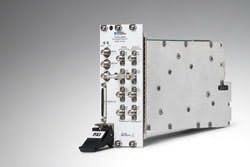'Software-Designed' Instrument Sets New Benchmarks at NIWeek
Aug. 22, 2012
4 min read
A record-setting 3,400 of the National Instruments faithful descended on Austin during the first week of August for the company's NIWeek 2012 celebration of all things LabView. The week-long technical conference for the company's user and developer community addressed the breadth and depth of NI applications — from embedded industrial control to Higgs boson research — and has evolved since its launch in 1994 into the primary venue for the company to unveil the fruit of its latest R&D efforts. This year, the company set its sights on the audacious task of "Redefining Instrumentation." And in this case, they weren't talking about a new pressure transmitter or better thermocouple, but about the high-frequency bench-top and rack-mount devices used to design and test complex electronic systems. Each of these high-performance, purpose-built devices can run into the tens of thousands of dollars, according to Charles Schroeder, NI director of marketing for test, who also led the company's development effort. The problem with traditional instrumentation is that it simply hasn't kept pace with advances in underlying computing technology, Schroeder explained, noting the explosion in smartphone capabilities over the past decade even as instrumentation performance and functionality have advanced only incrementally. He attributed the rapid advances in mobile device capability in part to an open platform together with a robust ecosystem of developers that could push device capabilities forward. "You can go from megabits to gigabits [in processor speed], but it doesn't help if the software doesn't advance."Instrument users, on the other hand, have had no choice but to wait — often in vain — for suppliers to add that needed functionality. "But now we're talking about Moore's Law for instrumentation — a fundamental shift in how instrumentation is designed and used," Schroeder said. NI calls this concept a "software-designed" instrument. And in NI's case, that means instrumentation developed from the bottom up using NI's LabView graphical design environment. This allows customers to use NI's instrumentation directly off-the-shelf, or to effectively reprogram the device "all the way down to the pins," Schroeder said.
National Instruments' RF vector signal transceiver (VST) represents new class of software-designed instrumentation that allows engineers and scientists to tailor open, field-programmable gate array (FPGA)-based hardware for their specific needs.
The company's first instantiation of a software designed instrument, also introduced at NIWeek 2012, is the world's first vector signal transceiver (VST), an instrument that combines radio frequency (RF) generation, RF analysis and high-speed digital I/O — all in a single instrument. The instrument is far smaller and less expensive than the three individual instruments it replaces — yet a high level of functional integration yields comparable accuracy and 10 times the speed of competitive alternatives, Schroeder said. "More importantly, the LabView architecture allows users to define the instrument functionality itself through software."At Qualcomm Atheros, for example, the VST is being used to design wireless networking devices for the next-generation 802.11ac wireless standard. "With 802.11ac, there's greater complexity and a geometric increase in the number of modes that must characterized," said Doug Johnson, director of engineering. "Instrumentation flexibility and to-the-pin control are critical for keeping our RF test process as efficient as possible, and we're pleased with the performance gains we've seen when testing with NI's new vector signal transceiver.""The VST allowed us to increase characterizations dramatically, from 30 to 40 points per insertion (in the test system) to hundreds of thousands on a single insertion," Johnson said. "It provides us freedom and flexibility in the way we develop our 802.11ac solutions for our customers, and has significantly improved our test throughput." "We have to be able to design at a higher level," added James Truchard, NI president and CEO. "Users and developers need higher levels of abstraction, and a systematic way of implementing these abstractions in design and test processes," he said. "The software-designed instrument provides an elegant method for handling complex systems, yet allowing access to the lower levels as needed."Indeed, the VST is only the first in what is envisioned as a new paradigm of instruments that put an unprecedented level of control and customization in the hands of its users, according to Eric Starkloff, vice president of product marketing, systems platform. "Already customers have been able to do things we couldn't imagine."Other new products introduced at NIWeek 2012 included a new "headless" CompactDAQ system for embedded applications that eliminates the need for a separate host PC; a RIO-based general purpose inverter controller (GPIC) for the rapid deployment of digital energy conversion systems; and LabView 2012, which notably includes demonstration code and recommended application architectures to save time, ensure scalability and lower maintenance costs of LabView applications.About the Author
Keith Larson
VP Content
Sign up for our eNewsletters
Get the latest news and updates

Leaders relevant to this article:

